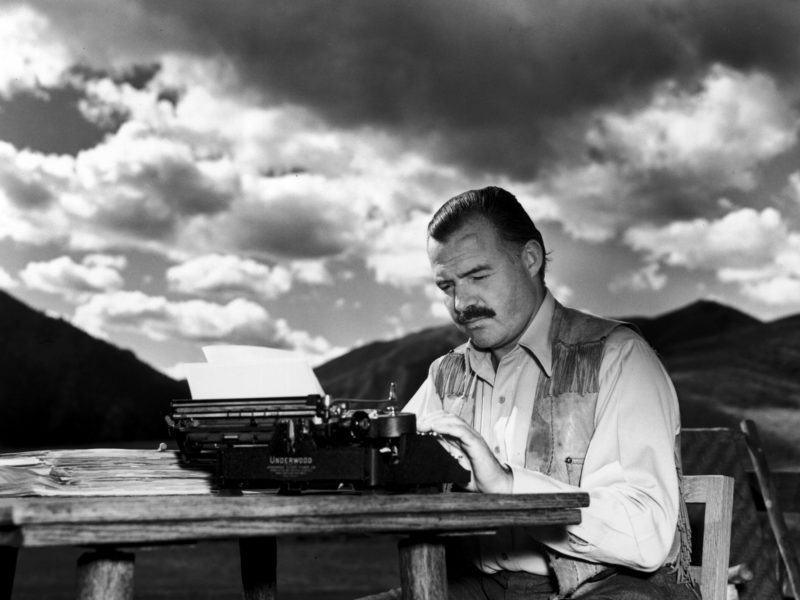Tales of Hemingway
for cello and orchestra (2015)
I. Big Two-Hearted River
II. For Whom the Bell Tolls
III. The Old Man and the Sea
IV. The Sun Also Rises
Instrumentation: 2 Flutes (2 doubles Piccolo), Oboe, English Horn, 2 Bb Clarinets, Bassoon, Contrabassoon, 2 Horns, 2 C Trumpets (straight metal mute, harmon mute stem-out), 2 Trombones (2. Bass) (straight metal mute), Timpani (Four drums; 32” 29” 26” 23″), Percussion: 2 Players; instruments are not shared: 1. Chimes, Vibraphone (yarn mallets and bow), Marimba (4.5 octaves), Mark Tree, Suspended Cymbal, Triangle; 2. Crotales (one octave), Glockenspiel, Triangle, Piccolo Snare Drum, Kick Drum, Suspended Cymbal, Tambourine, Castanets, Claves, Maracas, Mark Tree, Harp, Violoncello Solo, Strings
Publisher: Michael Daugherty Music
Duration: 28 minutes
World Premiere: April 17, 2015 / Schermerhorn Symphony Center, Nashville, Tennessee / Nashville Symphony Orchestra / Giancarlo Guerrero, conductor / Zuill Bailey, solo cello
Program Note:
Tales of Hemingway for cello and orchestra was commissioned by the Nashville Symphony and a consortium consisting of: the Asheville Symphony, the Detroit Symphony Orchestra, the El Paso Symphony Orchestra, the Erie Philharmonic, the Redwood Symphony, the South Florida Orchestra, and the Virginia Symphony. The world premiere was on April 17, 2015, with the Nashville Symphony Orchestra, under the direction of Giancarlo Guerrero,with Zuill Bailey, solo cello, at the Schermerhorn Symphony Center, Nashville, Tennessee.
Tales of Hemingway evokes the turbulent life, adventures, and literature of American author and journalist Ernest Hemingway (1899-1961). His terse, direct, accessible writing style, combined with a mastery of dialogue and brilliant use of omission and repetition, made him one of the most influential and original writers of the 20th century. Hemingway’s distinctive body of work was also informed by his larger-than-life experiences.
In his youth in Oak Park, Chicago, Hemingway was surrounded by music, where his mother was a prominent music teacher and he played the cello in school orchestras. Hemingway’s family owned a remote summer home on Walloon Lake near Petoskey, Michigan, where hunting, fishing, and camping were a family ritual. As an adult, Hemingway’s passion and expertise for deep-sea fishing in the Florida Keys and Cuba, big game hunting in Africa, bullfighting in Spain, and boxing were legendary.
Hemingway experienced the horrors and ironies of war as a Red Cross ambulance driver in World War I (1918) and as a journalist on the front lines of the Spanish Civil War (1937) and World War II (1944-45). In the 1920s, Hemingway was part of Gertrude Stein’s “Lost Generation” in Paris and haunted the bars and cafés with F. Scott Fitzgerald. During his lifetime, many of his works were made into Hollywood films, and his journalism and literature was syndicated in magazines and newspapers around the world, making Hemingway an international celebrity and a household name. Twenty-five minutes in duration, my cello concerto is divided into four movements, which are inspired by one of Hemingway’s short stories or novels:
I. Big Two-Hearted River (Seney, Michigan, 1925)
In this story, Nick Adams is an emotionally scarred and disillusioned soldier from World War I who treks to Northern Michigan for a camping-fishing trip to try to regain control of his life. I have composed serene and passionate music that evokes a leitmotif in Hemingway’s writing: his belief that one can be healed by the power of nature through exploring isolated outdoor terrains.
II. For Whom the Bell Tolls (1940, Spanish Civil War)
Hemingway tells the tale of the last three days in the life of Robert Jordan, an American teacher turned demolition expert who has joined the anti-fascist Loyalist guerillas in Spain. Jordan accepts a suicide mission to blow up a bridge only to fall in love with Maria, a young Spanish woman of the Loyalist guerilla camp. The cello strums and plucks, leading the martyr’s march to battle the Fascists and to Jordan’s eventual death. As the chimes explode at the conclusion of the movement, the epitaph of the novel rings forth: “And therefore never send to know for whom the bell tolls; it tolls for thee.”
III. The Old Man and the Sea (1952, Cuba)
In Hemingway’s Nobel Prize-winning novella, Santiago is a poor, old fisherman whose luck changes when he takes his small boat deep into the Gulf Stream. After an epic struggle, he catches a gigantic marlin, the largest fish of his career. As he makes the long journey home, sharks relentlessly attack his boat and devour the marlin. As a musical response, I have composed an elegy to the struggle of life and death between man and nature. The cello represents the old fisherman’s journey as he searches for the truths of man’s existence with dignity and grace.
IV. The Sun Also Rises (1926, Pamplona, Spain)
The main character in this ground-breaking novel is Jake Barnes, bitter and wounded by war, living in Paris as an unhappy expatriate journalist. Aimless in life, he makes a journey to the Festival in Pamplona, Spain. Along the way, he is joined by other adrift souls of the “Lost Generation,” such as Lady Brett, a promiscuous divorcée with whom Barnes was involved before the war. For the final movement of the concerto, I have created an exciting and dramatic sound world where I imagine Jake Barnes, his entourage (and Hemingway) in Pamplona at the Fiesta, watching the running of the bulls and reveling in the spectacle of the bullfights. We also hear musical illuminations of the novel’s enigmatic epigraph, “the sun also ariseth, and the sun goeth down, and hasteth to the place where he arose.”
-Michael Daugherty

